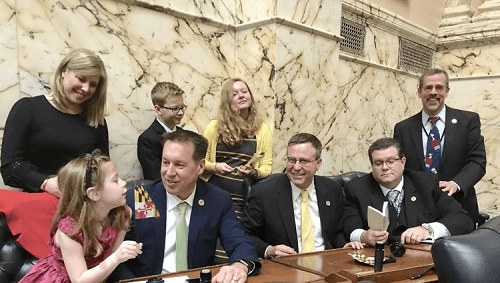
In this 2019 file photo, local legislators were joined on the House floor by family members as the General Assembly convened. From left are Samantha Corderman, Kerri Corderman, Del. Paul Corderman, R-Washington; Neilson Parrott, Charity Parrott, Del. Neil Parrott, R-Washington; Del. Mike McKay, R-Washington/Allegany; and Del. William Wivell, R-Washington.
1.4.20 – Herald Mail – ANNAPOLIS — It’s 90 days of hearings, debates and deal-making. And if past is prologue, Maryland will have hundreds of new laws by the time it’s over.
Lawmakers from around the state return to Annapolis this week for the 2020 Maryland General Assembly, with major changes to its membership — and leadership — for the second year in a row.
Last year’s session ended with the death of longtime House Speaker Mike Busch, who had battled health issues for some time before succumbing to pneumonia on April 7. Senate President Mike Miller, who has been fighting prostate cancer, announced in the fall his intention to step down as president as this year’s session gets underway. House Speaker Pro Tem Adrienne Jones, D-Baltimore County, was chosen during a special session in May to replace Busch as speaker; Sen. Bill Ferguson, D-Baltimore City, has been tapped to replace Miller.
Senate Judicial Proceedings Committee Chairman Bobby Zirkin and Education, Health and Environmental Affairs Committee Vice Chairwoman Shirley Nathan-Pulliam, both Baltimore County Democrats, announced their departures last month. Zirkin made his resignation official on Friday.
Two House members were forced to resign during the interim after being charged with felonies. Del. Tawanna Gaines, D-Prince George’s, pleaded guilty in October to federal wire fraud. Del. Cheryl Glenn, D-Baltimore City, was indicted last month on charges of federal wire fraud and bribery. She resigned Dec. 18.
But following the initial reorganization, legislators will get to work plowing through bills and setting a budget for the new fiscal year, which begins July 1.
How bills become law
A bill goes through a number of steps on its way to becoming state law, and only a fraction of the bills filed actually are approved. Here’s a summary of the process, with thanks to the Maryland Department of Legislative Services:
• Drafting — The Department of Legislative Services drafts bills requested by legislators who then review the draft and prepare it for introduction. Lawmakers may file bills before the legislative session begins — Del. Neil Parrott, R-Washington, has already filed four bills, according to the department.
• First reading — The reading clerk of the appropriate chamber (House or Senate) reads the number and title of the bill into the record at the beginning of a floor session, when the entire chamber is assembled for the day’s business. The clerk also indicates which committee will conduct hearings on the bill. Legislative Services then prepares an analysis of the bill before it is heard in committee.
• Committee work — Each chamber has standing committees that review proposed legislation. The House of Delegates has six standing committees that meet daily during the session; the Senate has four.
The committee schedules the bill for a hearing. The bill is presented to the committee, usually by the lawmaker sponsoring it, and citizens, lobbyists, local government officials and anyone else with an interest in the bill may speak or submit testimony in support or opposition. Following the hearing, the committee will vote on whether to give the bill a favorable recommendation, favorable with an amendment or unfavorable.
• Second reading — The bill is reported back to the floor with the committee’s recommendation. Bills with “unfavorable” recommendations go no further. If the committee has offered an amendment, the chamber first votes on the amendment. If it passes, another vote is taken on the bill as amended.
• Third reading — The bill’s final version is presented to the full chamber, and a vote is taken. No further amendments are permitted. If a majority vote in favor of the bill, it is sent on to the other chamber.
• Second chamber — The bill goes through the same process as in the original chamber, except that amendments can be made on the third reading. If an amendment is made, it must go back to the original chamber for a vote on whether to concur with the change. If the two chambers do not concur, the bill is sent to a conference committee.
• Conference committee — Three members of each chamber are appointed by the presiding officers to iron out differences between the versions of the bill. Their report is then sent to both houses, and if adopted, the chambers vote on final passage.
• Presentation to the governor — Bills that have survived all the previous steps are then presented to the governor. The governor can sign or veto a bill, or allow it to become law without his signature. The exceptions are constitutional amendments and the budget bill, which become law upon final passage and cannot be vetoed.
• Vetoes — The General Assembly can override a veto if three-fifths of the elected membership in each house votes to override.
The General Assembly convenes at noon Wednesday at the Maryland State House. This year’s legislative session ends at midnight April 6.
